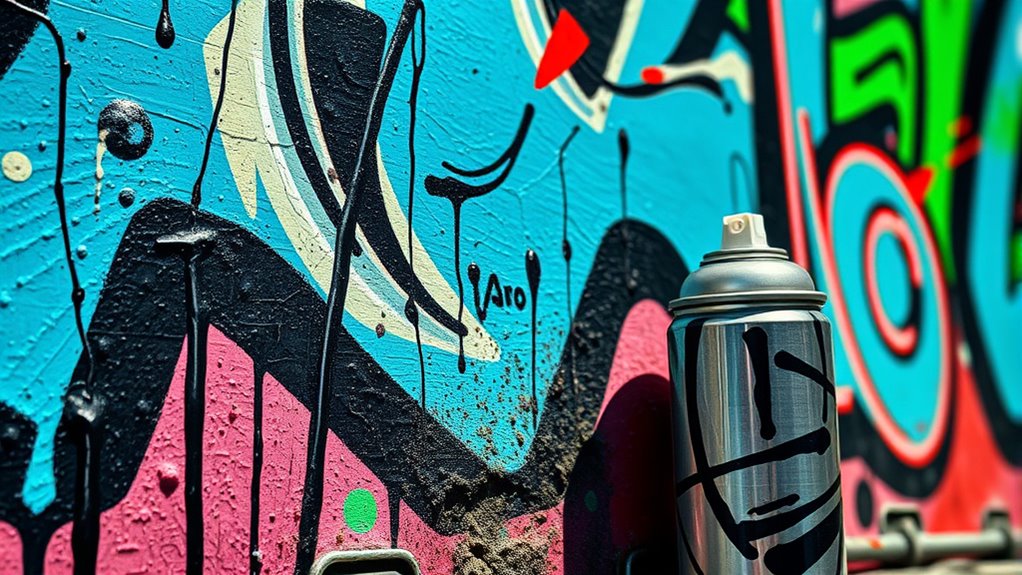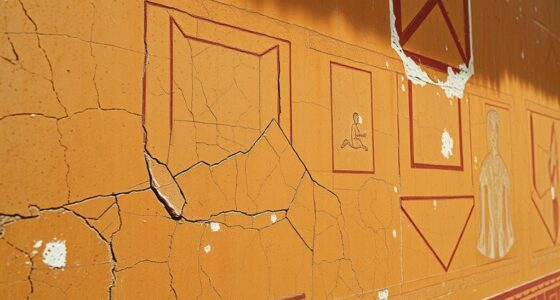To master graffiti, you combine spray can techniques like color blending to create vibrant, dynamic murals with seamless progressions between shades. You also use stencils for sharp, detailed designs that add precision and complexity. Combining these methods makes your work more professional and eye-catching. Developing both skills will expand your artistic toolkit and help you create impactful street art. Keep exploring, and you’ll discover even more ways to elevate your graffiti skills.
Key Takeaways
- Master color blending by layering shades for depth, smooth transitions, and vibrant, three-dimensional graffiti effects.
- Use spray cans to apply base colors, then add lighter or darker shades wet for seamless color gradation.
- Create stencils from sturdy materials to achieve precise, repeatable designs, enhancing mural detail and complexity.
- Combine freehand spray techniques with stencil art to add sharp details and layered visual richness.
- Developing skills in both spray blending and stenciling expands artistic versatility and improves overall graffiti quality.

Have you ever wondered how graffiti artists create their bold, vibrant designs? It’s a combination of skill, creativity, and the right techniques. One of the most impressive aspects of graffiti is the way artists blend colors seamlessly to produce eye-catching effects. Color blending involves layering different shades and hues to create depth, dimension, and a sense of movement within the artwork. When you’re working with spray cans, this technique requires a steady hand and an understanding of how colors interact. Artists often start with a base color and then gradually add layers of lighter or darker shades, blending them while the paint is still wet. This process allows for smooth gradations, making the artwork pop with vibrancy. Achieving this effect takes practice, but once mastered, it elevates graffiti from simple tags to stunning murals. Additionally, understanding asset division can help artists navigate legal aspects related to their work and collaborations.
On the other hand, stencil art offers a different approach. It involves cutting out shapes or designs from sturdy material like cardboard or plastic, which you then place on the surface to spray over. This method provides precision and repeatability, making it ideal for creating complex patterns or detailed images. Stencil art is especially useful when you want consistency across multiple works or when you need to quickly execute a design. The key is to guarantee your stencils are well-cut and securely positioned so the spray doesn’t bleed underneath. You can combine stencil art with freehand spray techniques to add layers of detail, shadows, or highlights, creating a richer visual experience.
Both techniques — color blending and stencil art — showcase the versatility of spray cans as tools. When you master color blending, your murals will have a dynamic, almost three-dimensional quality that draws viewers in. Meanwhile, stencil art allows you to replicate intricate patterns with ease, making it perfect for political messages, logos, or detailed imagery. As you experiment with these methods, you’ll find that they complement each other beautifully. You can create vibrant backgrounds with smooth color transitions and then overlay sharp, precise stenciled images. Combining these techniques adds complexity and sophistication to your work, allowing you to tell stories or convey messages more effectively. Ultimately, whether you prefer the fluidity of color blending or the precision of stencil art, honing these skills will expand your artistic toolkit and help you produce graffiti that truly stands out.
Frequently Asked Questions
How Do Graffiti Artists Choose Their Color Palettes?
You choose your color palette by applying color theory, considering how colors interact and evoke emotions. You think about contrast, harmony, and visibility to make your artwork stand out. During palette selection, you experiment with bold or subtle shades that fit your message or style. You might also consider the environment or surface, ensuring your colors complement or pop against it. This careful process helps you create a striking, cohesive graffiti piece.
What Safety Equipment Is Recommended for Graffiti Artists?
You should always wear protective gear and ventilation masks when graffitiing. Protective gear like gloves and goggles shields your skin and eyes from harmful chemicals. Ventilation masks prevent you from inhaling toxic fumes from spray cans, especially in enclosed spaces. By prioritizing safety equipment, you reduce health risks and ensure a safer, more enjoyable graffiti experience. Always choose quality gear and use it properly for maximum protection.
How Long Does a Typical Graffiti Piece Last Outdoors?
A typical outdoor graffiti piece can last anywhere from a few months to several years, depending on factors like weather, location, and spray paint quality. To improve graffiti preservation and outdoor durability, you should consider applying protective coatings, like sealants, which shield the artwork from rain, sun, and pollution. Proper surface preparation and using high-quality paints also help extend the lifespan of your graffiti, ensuring it stays vibrant longer.
Are There Legal Ways to Practice Graffiti Art?
Yes, you can practice graffiti art legally by participating in street art festivals and graffiti community workshops. These events give you a safe space to develop your skills and showcase your work without legal worries. Many cities host these programming opportunities, encouraging artists to express themselves creatively and responsibly. By joining such events, you’ll learn new techniques, connect with other artists, and contribute to vibrant, legal street art scenes.
What Are the Most Common Mistakes Beginners Make?
You often make mistakes like rushing your tagging techniques or rushing your graffiti lettering, which can make your work look sloppy. You might also overuse spray paint or not practice enough, leading to uneven lines and drips. Focus on controlling your spray can and refining your styles gradually. Remember, patience and consistent practice will improve your skills and make your graffiti art stand out.
Conclusion
Now that you’ve explored the vibrant world of graffiti techniques, imagine yourself wielding cans and stencils like an artist’s brush, transforming blank walls into bursting canvases of expression. Every spray and cut is a stroke of rebellion, a splash of color in a concrete jungle. Embrace these methods, and let your creativity run wild—because in graffiti, your imagination is the only limit, turning ordinary surfaces into a tapestry of vivid stories waiting to be seen.









